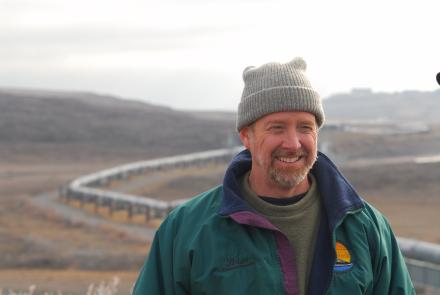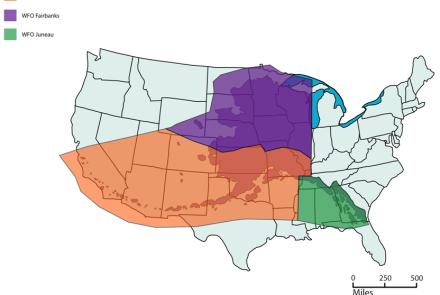Stone Tools and Climate Changes
Roger Powers gave a seminar at the Geophysical Institute a few weeks ago. His topic was evidence of past global climate changes. Climate change--past, present, and future--is a common subject for talks at the institute, but not from his particular perspective. Dr. Powers is a member of the University of Alaska Fairbanks department of anthropology, and he's an expert on northern archaeology.
Some of what he had to say and show was tough going for the assembled meteorologists, glaciologists, and geologists (not to mention at least one science writer scribbling away in the back row). Slide after slide illustrating stone tools appeared on the seminar room screen, while Powers explained changes in form and technology in characteristic points, scrapers, and the cores from which the tools were made.
The audience needed to understand that the suites of implements were diagnostic. They're nearly all we have to understand and categorize cultures that rose and fell in the north before the advent of written records.
The importance of distinguishing among cultures became clear when Powers showed a section through an excavation near Healy. Going backward through time as well as downward from the present ground level, the archaeologists dug through windblown silt laden with stone tools and fragments belonging to one culture. Then they hit a layer of sand--barren sand, from their view, with no human artifacts at all.
Below the thick sand, the excavators encountered more windblown silt and more stone implements. These were the remains of an earlier culture. The sand separated two distinct schools of toolmaking by the span of a few hundred years.
Carbon dating of charcoal above and below the sand shows it was laid down between 10,700 and 11,100 years ago. It blew in, just the way lighter particles of silt blow in today. That means the times were especially windy, dry--and cold. It was a period in which people who lived by hunting couldn't thrive in the Healy-Nenana River area. They went away, probably following the animals in search of a better place to live, perhaps further south where they reemerged as the Clovis Culture.
There's evidence from all over the Northern Hemisphere that those were harsh times. This era when the Ice Age almost returned even has a name; it's called the Younger Dryas, in honor of a kind of plant that thrived while punier vegetation went roots-up.
Other correlations between human and geologic evidence of climate changes have been found. For example, while the earliest people in interior Alaska were packing up and moving away, a Mesolithic culture was taking shape in Siberia. Eventually their stone toolkit included adzes for woodworking--an indication that trees had returned as the climate changed to permit their growth.
Sketchy clues like this appear all over the north, but the clearest pattern emerges in Greenland. People reached the shores of that gigantic island about 4000 years ago. They were members of the Arctic Small-Tool Culture, and their artifacts have been found from the Taymyr Peninsula, midway along the Soviet shore of the Arctic Ocean, through northern Alaska, the Canadian High Arctic islands, and across the top of Greenland.
That pervasive spread could only come about under favorable climate conditions. When things cooled down between 3500 and 3000 years ago, the toolmakers abandoned northern Greenland and the Canadian islands. Between 3000 and 2500 years before the present (BP for short), people returned. Their tools had changed, and their weapons show they now hunted sea mammals. The next thousand years were cold, and the high Arctic, including all Greenland, was virtually abandoned.
By 1500 years BP, warmer weather and people were returning to the farthest northern lands. The Arctic rim was completely repopulated by 1000 BP, a climatic high that let Norse immigrants think their westernmost colony could be called a green land (though possibly, as Powers suggested, the name of Greenland marks the first real-estate scam in history).
Five hundred years ago, Greenland again turned colder. The Scandinavians died out, leaving their own artifacts in testimony to the changed climate.
The climate changes implicit in the pulses of habitation and depopulation are confirmed by the pattern of changes in the contents of ice cores from the Greenland ice sheet. Looking at it another way, the glaciologists' and geophysicists' interpretation of the ice cores has been confirmed by the archaeologists' study of people's migrations. Either way, we have a better glimpse of prehistoric weather---and a better sense that the present climate is a passing thing.




